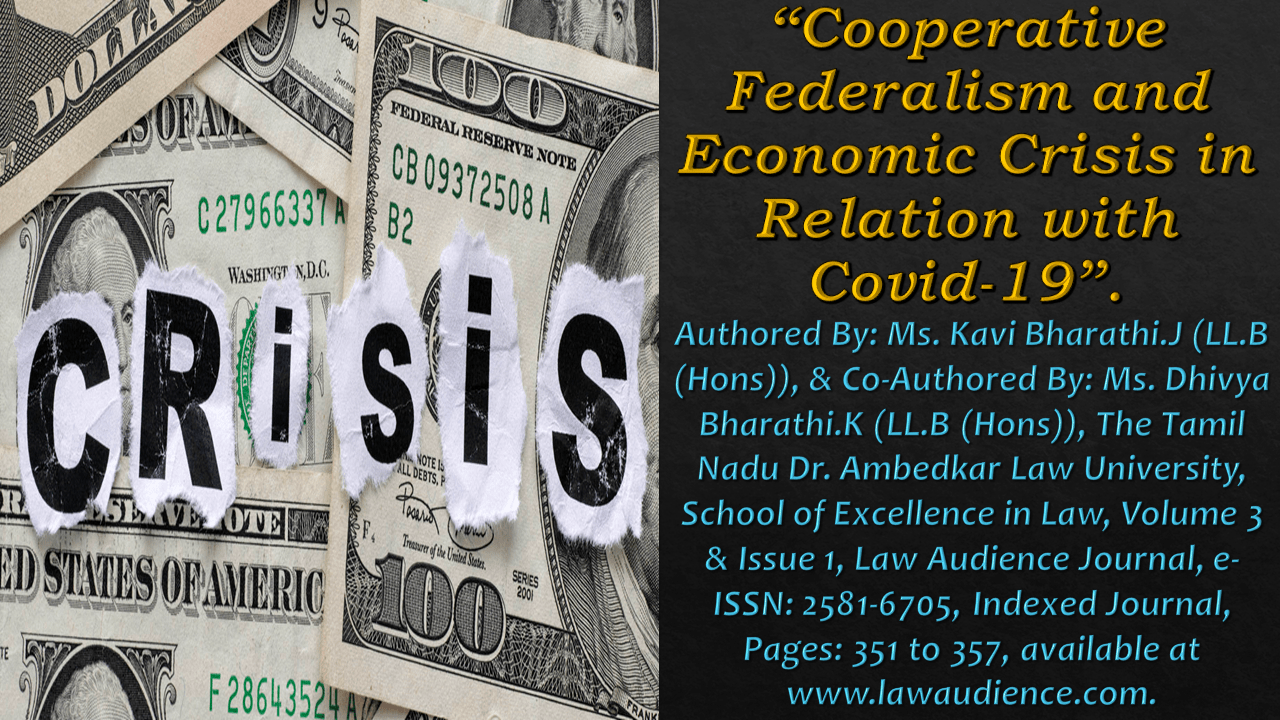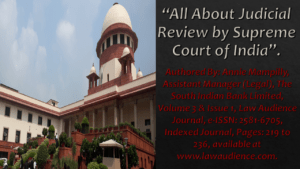Click here to download the full paper (PDF)
Authored By: Ms. Kavi Bharathi.J (LL.B (Hons)), & Co-Authored By: Ms. Dhivya Bharathi.K (LL.B (Hons)), The Tamil Nadu Dr. Ambedkar Law University, School of Excellence in Law,
Click here for Copyright Policy.
“Strengthening the system and spirit of cooperative federalism, my government is taking the states along to achieve national goals.” ~ Ram Nath Kovind
I. INTRODUCTION:
“The Indian economy has hit very hard due to ongoing Coronavirus pandemic is driven global crisis. The entire world is passing through this great uncertainty. Primarily two major challenges that the Indian economy is facing right now. The first is to save the country from this spread by Coronavirus (Covid-19) which is a health emergency because saving the lives is the most important, the principal concern by the government. The second is to save the economy from this uncertainty due to the dual effects of the pandemic and the global lockdown. This article will be dealing with the centre & state coordination and how developing country like India tackle this economic crisis results from this Pandemic”.[1]
II. CENTRE’S ASSISTANCE IN ADMINISTRATION OF STATES:
Though India adopts a federal system of Government, somewhere in the Constitution of India it was clear Union prevails over State. So, constitutionalists compiled this as a Quasi-Federal system of Government. Article 248 of the Indian Constitution gives Residuary power to the Union which clearly shows that Union is stronger than State. Public health and sanitation are a subject matter of a State but to tackle with this pandemic centre adopts Disaster Management Act to regulate the spread of disease and regulates the State in these aspects. By adopting this Act both Centre and State operate co-operatively to prevent the spread of covid and regulates the people by imposing some restrictions like curfew, but due to this curfew Indian Economy faces major downfall[2]. Ministry of Health, set a conversation on drafting Public Health (prevention, control and management of epidemics, Bio psychological oppression and Disaster) Bill,2017. This Bill is regarding obligation of Centre and State during health-related crisis. This draft bill was set up 3 years prior but never prioritised by the Government. When this Bill is passed then there could be some changes in duties of Centre and State during Pandemic.
III. THERE EXIST THREE MAJOR ISSUES WHERE THE QUESTION OF COOPERATIVE FEDERALISM ARISES:
III.I MIGRANT CRISIS:
As India imposed very short notice of lockdown which is unexpected phenomenon in the history of Indian democracy. The major drawback of the centre and state regarding migrant was leaving migrant labourers in a state of despair without extending the help. When State takes necessary steps to help migrants to reach their respective states, it fails to provide adequate transportation facility which gave huge distress among the migrants. Migrants faced huge risk both financially and medically[3]. In general opinion, Centre fails to regulate the matter. Even after adoption of Disaster management Act Centre fails to regulate the State as a whole result in huge outbreak of covid cases as a large and lacks to provide basic need to the migrant workers.
Ministry of Home Affairs allows State to co-ordinate the transportation of migrant worker individually. Ministry of Health and Family affairs directs State to provide relied camps for migrant workers. Though this was not satisfied to some extent. Therefore, on viewing the crises Supreme Court takes over the situation by witnessing the inadequacy in Government action. Further it provides interim direction to the Centre, State and UTs. Some of those directions are transportation of migrant workers to their native within 15days, to setup counselling centres, to withdraw prosecution and complaints filed against migrant workers under Disaster Management Act, etc. This clearly shows that both Centre and State fails to work cooperatively even in major crisis.
III.II VACCINES CRISIS:
Previously, procurement of vaccines solely lies upon centre and in later stage it was liberalised to State and to other private sectors. The problematic point herein is India being a vaccines supplier planned to provide vaccines to several other countries this would probably results in shortage of vaccines in India[4]. Virologists Shahid Jameel pointed as ” more thought should have gone to sustain both the exports and domestic needs”.
Until March India vaccinated a lesser number of its own people as compared with overseas supply. Generally, supply of vaccines would be of centralised proclamation so that the entire population of the country get benefited. Centre should ensure and prioritize its own people first and then it could supply the excess to other countries. As we already in shortage of vaccines supply, the decision of centre in stoppage of exports seems to be delayed process. Overall, India reaches only 25% of its target[5]. This shows that Centre lacks to give caution and importance for its own people. Centre is likely to distribute vaccines equally to all the states but there lie controversies between States that centre fails in providing adequate vaccines to the state which suffers a lot, State which suffers more and State which suffers less both gets equal range of supply of vaccines. This is evident that India fails in cooperative federalism.
III.III OXYGEN DEFICIT:
In 2020, Ministry of Commerce Department of promotion of industry and industrial Trade forms “Oxygen mentoring Committee”. This is to discuss with the oxygen manufacturers regarding potential requirements. Even State Government apprised the need for setting up oxygen plants at bigger hospitals and the funds also raised from PM CARES Fund[6]. But at that time Virus outbreak was not too large, so, many States fails to adopt help from centre. This leads State to face extreme difficulty in managing the shortage of oxygen supply in Second wave of virus’s outbreak. Many States fails to give adequate public health and started blaming private hospital for lack of oxygen supply and taking away lives of many.
It’s the State to ensure working of both public and private health centres and the Centre has to take effective steps in regulating the health centres in case of National emergency in order to ensure proper health and sanitation to entire population of the Country in case of pandemic outbreak[7].
In close view with the Delhi Oxygen shortage case, High Court of Delhi directed Central Government with regard to the supply of 700MT per day liquid medical oxygen as per the directions passed by Supreme Court, Centre on failing to comply with the matter High Court take over contempt proceedings against Centre officers. This issue shows that Centre’s weakness in supply chain and lack of cooperation between State and Centre[8].
IV. INDIA’S HIGH INFLATION:
During this Pandemic India is experiencing stubbornly high inflation. The average price level is structurally increasing. Inflation is not just problematic in the short to medium term but even bigger problem in the longer term. Among various ways in which Covid-19 has affected the economy, out of which impact on inflation affect each & ever person. Before the pandemic struck, inflation had crossed the tolerance level of 6% in 2019[9]. In most countries, the pandemic pulled inflation down for a certain period, after that, it firmed up again in the nine countries. Only Germany and Japan, deflation conditions have sustained for a longer period. But in India the dip in inflation went below the last year’ average level.
V. FISCAL DEFICIT:
In the budget presented in February 2020 the Government had pegged the fiscal deficit as 3.5% of the GDP. Again, it revised the estimates in budget 2021-2022, due to the curfew, country may suffer to yield the revenue. So, the revised estimation was about 9.5% of the GDP, but its Indian economy faces deficit of 9.3% of GDP which would be a mild success.
This is due to higher spending and lower revenue collection on account of Covid-19. This can be carried out better with market borrowings by way of issuing bonds and selling them via bank. With this view Finance Minister Nirmala Sitharaman states that government aims to steadily reduce the fiscal deficit to 4.5% of GDP by 2025-26.
By the way 15th Finance Commission for 2021-26 have recommended a path for fiscal consolidation for the centre in reducing this fiscal deficit. In RBI data, the India’s GDP growth is estimated by 7.5% in 2020-2021 and grow by 10.5% in 2021-22.
The economy remains strong as gradual scaling back along with the support of “Atma Nirbhan Bharat Mission” has placed the economy firmly on the path of recovery. Under this mission measures taken by RBI amounting to about Rs. 27.1 lakh crore-more than 13% of India’s GDP to combat the impact of the Covid19 pandemic and to receive economic growth. Moreover, restrictions to people not only affected income and consumption, they also largely unsuccessful in continuing the spread of virus. As a result, there is a fall of economic activity in large. The budget for the fiscal year April 2021 to March 2022 also shift towards demand side stimulus.
VI. ECONOMIC DOWNFALL:
The Covid-19 pandemic disrupt the supply of goods & lead to a rise in price. Besides being deadly, the second wave poses a greater risk to the Indian economy than the first one and pushes the Indian economy into deal slowdown.
A low interest rate is essential to cope up the business to borrow & spend when the economy is in a slowdown. RBI state the healthcare infraction and vaccination are necessary, which could help in attaining economic stability. According to the international monetary fund (IMF), many economies faced negative per capita income growth in 2020.
The world trade organisation (WTO) indicated a clear fall in the global trade from 13% to 32%. GDP growth of 19% in 2020[10]. A rebound in the growth of the Indian economy in 2021 at a rate of 7.4%. At this moment, business is very vulnerable due to this economic crisis. People have been facing sudden loss in their incomes, this caused major drop in demand. To rescue the economy, India has to announce a range of fiscal & monetary stimulus packages. Structural reforms are must and should continue to fall on strengthening the country’ economic, only then some contribution towards a REBOOTING THE INDIAN ECONOMY[11].
VII. CONCLUSION:
Even developed countries were struggling to tackle this pandemic situation, but developing countries like India trying to tackle it with huge care. Since this was the first time India facing this type of crises, Indian Government working on it efficiently. But there exists some lack of coordinative mechanism with State in area of finance, supply chain and health care. And moreover, Disaster and epidemic disease is nowhere mentioned as a subject matter in any of the List in Seventh schedule of Indian Constitution. So, it’s necessary that Disaster and epidemic disease to be listed in Union or Concurrent list in order to get centralised control during pandemic situations.
Again, one of the major challenges faced by Indian government is strengthening of cooperative federalism and promoting coordination between States and Centre. During the time National crises, we could witness such lack of coordination between States and Centre.
Many of the social activists and researchers point out that this outbreak of COVID is a disaster created by complacency of the Indian Government, rather than tackling the issue it’s busy in narrating their perspectives.
As a whole Centre and State have to work cooperatively in the matters of finance, supply chain and health care. Also, Governments must embrace a collaborative federal by harmoniously.
References & Footnotes:
[1] Louise Tillin, Centre and States Need to Coordinate, Not Compete, CASI SAS UPENN, (Jan 25/2021 5:00 PM) https://casi.sas.upenn.edu/iit/louisetillin.
[2] Niharika Salar, LAW NUS, (Jun 26/2021 9:00 AM), https://law.nus.edu.sg/impact/covid-19-indias-institutional-response-the-centre-state-relationship/.
[3] Nivedita Jayaram & Priyanka,The Covid-19 migrant crisis showed why the state must protect living wages as a public good, SCROLL, (Jun 27/2021 9:00AM) https://scroll.in/article/983343/the-covid-19-migrant-crisis-showed-why-the-state-must-protect-living-wages-as-a-public-good.
[4] FE online, Covid-19: Why India is facing vaccines shortage, FINANCIAL EXPRESS, (Jun 27/2021 3.30PM)), https://www.financialexpress.com/lifestyle/health/covid-19-why-india-is-facing-vaccines-shortage/2248748/.
[5] Samanth Subramanian, Why is India, the world’s largest vaccines producer, running short of vaccines?, QZ, (Jun 28/2021 10:30 AM), https://qz.com/2004650/why-does-india-have-a-covid-19-vaccines-shortage/.
[6] Amit Thadhani, Preventing a Repeat of the COVID-19 Second-Wave Oxygen Crisis in India, ORFONLINE, (Jun 28/2021 5:00 PM) https://www.orfonline.org/research/preventing-a-repeat-of-the-covid-19-second-wave-oxygen-crisis-in-india/.
[7] Sandhya Venkateshwaran, from vaccines to oxygen, Centre state needs to end, THE PRINT https://theprint.in/opinion/from-vaccines-to-oxygen-centre-state-volleyball-needs-to-end/646125/.
[8] Madlen Davies and Rosa Furneaux, After India: The Countries on the Brink of Another COVID Oxygen Crisis, SCIENCE WIRE, (Jun 28/2021 6:00 PM) https://science.thewire.in/health/after-india-the-countries-on-the-brink-of-another-covid-oxygen-crisis/.
[9] Marshall Reinsdorf, Data Disruption: The Impact of COVID-19 on Inflation Measurement, BLOGS IMF, (Jun 28/2021 9:00PM)https://blogs.imf.org/2020/11/10/data-disruption-the-impact-of-covid-19-on-inflation-measurement/.
[10] Ramya Nair, Pandemic pushes India’s fiscal deficit to 9.5% in 2020-21, estimated at 6.8% in 2021-22, THE PRINT, (Jun 29/2021 11:00 AM)https://theprint.in/economy/pandemic-pushes-indias-fiscal-deficit-to-9-5-in-2020-21-estimated-at-6-8-in-2021-22/595806/.
[11] Rahmiye Figen Ceylan, Burhan Ozkan, and Esra Mulazimogullari, Historical evidence for economic effects of COVID-19, NCBI, (Jun 29/2021 7:00 PM)https://www.ncbi.nlm.nih.gov/pmc/articles/PMC7270155/.
Cite this article as:
Ms. Kavi Bharathi.J & Ms. Dhivya Bharathi.K, Cooperative Federalism and Economic Crisis in Relation with Covid-19, Vol.3 & Issue 1, Law Audience Journal, Pages 351 to 357 (8th July 2021), available at https://www.lawaudience.com/cooperative-federalism-and-economic-crisis-in-relation-with-covid-19/.



